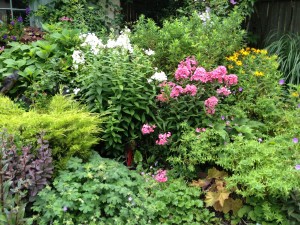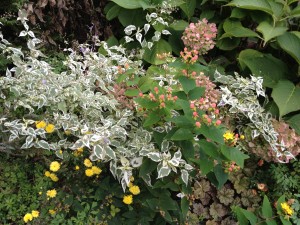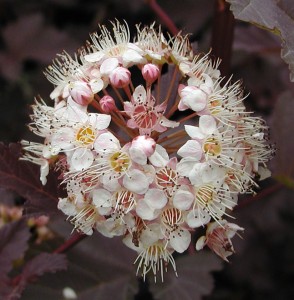Gardeners are constantly subjected to claims that this and that cultivar of a known genus is the greatest, the most floriferous, the earliest to flower, the longest to flower, the most disease resistant, etc. However, until we’ve actually grown them in our landscapes, we don’t know whether these claims are hype or reality.
Hypericum, commonly known as St.Johnswort, is a woody shrub with yellow flowers and reddish-brown seedheads. There are several cultivars that have been on the market for years. For the past four years, I have been trialing two in the Hypearls series. One died almost immediately but the other has been a winner. In fact, Hypericum Hypearls™ Renu has grown so well that I had to transplant it this year to a different site where it would have more space and the height would be more acceptable.
When I received it in 2011, it was a tiny plant and I planted at the front of one my perennial beds. By June of this year, it was two feet high and wide and shading out many other plants. The flowers are the typical butter yellow with rounded petals held above the green foliage that has a thin red edge when it foliates. What distinguishes this series are the berries which are extremely attractive. The ones on Renu start out as cream but eventually turn bright pink. Others in the series have berries that are cream, salmon, or deep red. Planted in full sun and average to dry soil, these small shrubs will brighten the landscape from June until frost. In early spring, cut back the stems to ground level because the flowers and berries will only appear on new wood.
I’ve been growing Physocarpus opulifolius ‘Diabolo’ for several years and love its many season appeal: purple foliage, pink buds, white flowers, red fruits and bright orange fall foliage color. It does, however, require a great deal of space because it wants to be the big guy – 10’x10’. I am delighted that there is finally a baby sister who has two names: Little Devil™ and ‘Donna May’. She only grows four to five feet high and wide but has all of the other attributes of her big brother. The foliage and flowers are a bit smaller than those of ‘Diabolo’. This is one tough shrub. In my driveway bed, it grows under the most horrendous conditions: part shade, wet in spring, dry in summer but seems not to be fazed at all.

Phlox ‘Coral Creme Drop’ with Phlox ‘Blushing Shortwood’, Geranium ‘Rozanne’, and Rudbeckia ‘Pot of Gold’ last summer
Phlox paniculata is a mainstay of the perennial border but finding cultivars that are truly mildew resistant is a constant search. Even when some of the supposedly resistant cultivars still exhibit mildew. I have yet to see it on ‘Coral Crème Drop’ which has been in my garden since 2011. As you might surmise from the name, the flowers are a coral pink that blend very well with virtually any other color. It grows about two feet high in my garden but might only grow eighteen inches in yours.
 I’ve been a fan of Helianthemum nummularium (Common Rockrose) for years. They are used quite commonly in England in sunny dry gardens and I purchased ‘Wisley Pink’, a pale pink cultivar with gray foliage, many years ago after I returned from England. In 2008, I received a sample of ‘Hartswood Ruby’. It has deep green foliage and ruby red flowers. Both are planted in the same bed that has outstanding drainage. Unfortunately, this past winter destroyed ‘Wisley Pink’ but ‘Hartswood Ruby’ came through with flying colors. I love the color. If you saw a slice of berry pie that was this color, you would devour it in no time flat. Even when it’s not in bloom, the form and foliage color are very attractive.
I’ve been a fan of Helianthemum nummularium (Common Rockrose) for years. They are used quite commonly in England in sunny dry gardens and I purchased ‘Wisley Pink’, a pale pink cultivar with gray foliage, many years ago after I returned from England. In 2008, I received a sample of ‘Hartswood Ruby’. It has deep green foliage and ruby red flowers. Both are planted in the same bed that has outstanding drainage. Unfortunately, this past winter destroyed ‘Wisley Pink’ but ‘Hartswood Ruby’ came through with flying colors. I love the color. If you saw a slice of berry pie that was this color, you would devour it in no time flat. Even when it’s not in bloom, the form and foliage color are very attractive.
Which new cultivars do you think live up to their hype?






0 Comments